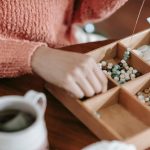If you’ve ever wondered how mulberry silk fabric is made, you’ve come to the right place. In this article, we’ll guide you through the step-by-step process of creating this luxurious material.
From gathering mulberry silk cocoons to weaving the silk fabric, we’ll cover every detail.
So grab a cup of tea, sit back, and get ready to discover the fascinating world of mulberry silk production.
Let’s dive in!
Table of Contents
Gathering Mulberry Silk Cocoons
To gather mulberry silk cocoons, you’ll need to carefully handpick them from the mulberry trees. Mulberry silk farming involves the cultivation of mulberry trees, which are the primary food source for silk worms.
The life cycle of a silk worm begins when a female moth lays eggs on the leaves of the mulberry tree. These eggs then hatch into tiny silk worm larvae. The larvae feed on the mulberry leaves, growing rapidly and shedding their skin several times during this stage.
After about a month, the silk worms spin cocoons around themselves using the silk they produce. This is where the valuable mulberry silk is found. To gather the cocoons, you must delicately pluck them from the branches of the mulberry trees. It is important to handle them with care to avoid damaging the delicate silk fibers inside.
Once the cocoons are harvested, they are boiled to loosen the silk fibers and then unraveled to obtain the raw silk. This process is repeated multiple times to obtain a sufficient quantity of silk for fabric production.
Harvesting and Preparing Mulberry Leaves
In this section, you’ll learn about the benefits of mulberry leaves and the process of silk production.
Mulberry leaves are not only nutritious, but they also have medicinal properties that can improve your health.
Understanding the silk production process will give you insight into the intricate steps involved in creating this luxurious fabric.
Mulberry Leaf Benefits
The benefits of mulberry leaves include improving digestion and boosting the immune system. Mulberry leaves are rich in nutrients such as vitamins A, C, E, and K, as well as minerals like calcium, iron, and potassium. These nutrients play a vital role in maintaining overall health. Additionally, mulberry leaves contain antioxidants that help fight against free radicals in the body, reducing the risk of chronic diseases. One way to enjoy the benefits of mulberry leaves is by consuming them in the form of tea. Mulberry leaf tea has been used for centuries in traditional medicine for its medicinal properties. It can help with digestion, promote weight loss, and even lower blood sugar levels. Incorporating mulberry leaves into your diet can be a simple and effective way to improve your overall well-being.
| Nutrients | Benefits |
|---|---|
| Vitamins A, C, E, and K | Supports immune system |
| Calcium, iron, and potassium | Promotes bone health and blood circulation |
| Antioxidants | Fights against free radicals and reduces risk of chronic diseases |
Silk Production Process
Learn how you can cultivate silkworms at home and be a part of the silk production process.
Silk production techniques involve rearing silkworms, harvesting their cocoons, and extracting the silk fibers.
To start, acquire silkworm eggs or larvae and provide them with a suitable environment, including a clean and spacious container, fresh mulberry leaves, and proper temperature and humidity.
As the silkworms grow, they will consume the leaves and eventually spin their cocoons.
Once the cocoons are formed, carefully harvest them without damaging the delicate silk threads.
To extract the silk fibers, boil the cocoons to soften the silk gum and then unwind the fibers onto a reel.
These raw silk fibers can be processed further to produce silk fabric, which involves steps like degumming, spinning, and weaving.
Silk Worm Rearing and Cocoon Harvesting
Silk worm rearing and cocoon harvesting is an essential step in making mulberry silk fabric. To understand this process, it is important to know about the silk worm’s life cycle and the properties of silk fabric.
The life cycle of a silk worm begins when a female silk moth lays eggs on mulberry leaves. These eggs hatch into tiny silk worms that immediately start feeding on the leaves. They undergo several molting stages, shedding their skin and growing larger until they reach their full size.
Once the silk worms have reached their maximum size, they spin cocoons made of silk threads. These cocoons serve as protection during the pupal stage, where the silk worm transforms into a silk moth. The cocoons are carefully harvested before the silk moths can break out, as the intact cocoons yield the finest silk fibers.
Silk fabric is known for its luxurious feel and natural sheen. It is incredibly lightweight and breathable, making it ideal for clothing and bedding. Silk also has excellent moisture-wicking properties, keeping you cool and dry. Additionally, silk is hypoallergenic and resistant to mold and mildew.
Degumming the Silk Cocoons
When it comes to the silk cocoon degumming process, understanding the benefits is crucial.
You’ll learn how this process removes the sericin, or silk gum, from the cocoons, resulting in a smoother and more lustrous silk fabric.
Additionally, degumming helps improve the dyeability and overall quality of the silk, making it a necessary step in the production of high-quality silk products.
Silk Cocoon Degumming Process
The first step in the silk cocoon degumming process is soaking the cocoons in hot water. This helps to loosen the sericin, a natural gum-like substance that holds the silk fibers together. As you immerse the cocoons, you can imagine the steam rising from the water, creating a warm and inviting atmosphere.
Next, gently agitate the cocoons to encourage the sericin to dissolve. The water becomes cloudy as the gum is released, revealing the smooth, delicate strands of silk.
Finally, carefully remove the degummed cocoons from the water and allow them to dry. As the water evaporates, the silk fibers become even more lustrous, soft, and comfortable.
These silk cocoon degumming techniques are essential for enhancing the mulberry silk fabric properties, such as its strength, durability, and luxurious feel.
Benefits of Degumming
Now that you understand the process of silk cocoon degumming, let’s explore the benefits and advantages it brings to the production of mulberry silk fabric. Degumming plays a crucial role in transforming raw silk into a luxurious and high-quality material.
Here are some key advantages of degumming:
| Benefits | Advantages |
|---|---|
| Enhanced Appearance | Degumming removes the sericin protein from the silk fibers, resulting in a smoother, shinier, and more lustrous fabric. |
| Improved Texture | The removal of sericin also leads to a softer and more delicate texture, making mulberry silk fabric comfortable to wear. |
| Increased Strength | By eliminating the gum, degumming strengthens the silk fibers, enhancing their durability and longevity. |
| Better Dye Absorption | Degumming improves the fabric’s ability to absorb dyes, allowing for vibrant and long-lasting colors. |
| Hypoallergenic Quality | The process of degumming significantly reduces the presence of allergens in mulberry silk fabric. |
Overall, degumming is essential in producing mulberry silk fabric with its luxurious appearance, soft texture, durability, vibrant colors, and hypoallergenic quality.
Spinning the Silk Filaments
Spinning mulberry silk filaments creates a strong and smooth yarn for weaving. The silk spinning techniques used to transform these filaments into yarn are crucial in determining the quality and properties of the final fabric.
Here are three aspects to consider when it comes to silk spinning techniques and silk filament properties:
-
Fine and even: Skilled spinners carefully draw out the silk filaments, ensuring they are of consistent thickness throughout the yarn. This results in a smooth and uniform texture, essential for creating a luxurious fabric.
-
Strong and durable: The silk filaments are twisted together to create a strong yarn that can withstand the tension and stress of weaving. This strength is a testament to the inherent properties of the silk filaments themselves, known for their remarkable tensile strength.
-
Lustrous and silky: The spinning process enhances the natural sheen of the silk filaments, resulting in a fabric that exudes a radiant glow. The smooth and slippery nature of silk fibers also contributes to the soft and silky feel of the finished fabric.
Weaving the Silk Fabric
To achieve a strong and durable weave, you can adjust the tension of the silk yarn as you interlace it on the loom. Weaving techniques play a crucial role in creating high-quality silk fabric with desirable properties.
Silk fabric is known for its smoothness, luster, and strength. By using the right weaving techniques, you can enhance these properties and create beautiful and functional silk fabric.
One commonly used weaving technique for silk fabric is the plain weave. In this technique, the warp and weft yarns are interlaced in a simple over-under pattern, creating a balanced and stable fabric. The plain weave is easy to achieve and results in a strong and durable fabric with a tight and even texture.
Another popular weaving technique for silk fabric is the satin weave. In this technique, the warp yarns float over multiple weft yarns, creating a smooth and shiny surface. Satin weave is often used to enhance the luster and drape of silk fabric, making it ideal for luxurious garments and accessories.
Lastly, the twill weave is another commonly used technique for silk fabric. In this technique, the warp and weft yarns are interlaced in a diagonal pattern, creating distinctive diagonal lines on the fabric. Twill weave adds texture and depth to silk fabric, making it suitable for a wide range of applications.
Finishing and Dyeing the Mulberry Silk Fabric
After you have finished weaving the silk fabric, you can enhance its appearance and color by dyeing it using various techniques. Dyeing is an important step in the fabric finishing process that adds vibrancy and personality to your silk fabric.
Here are three dyeing techniques that you can use to create stunning effects:
-
Tie-dye: This technique involves tying sections of the fabric with rubber bands or strings before immersing it in dye. The tied areas resist the dye, creating beautiful patterns and designs. You can experiment with different tying methods to achieve unique and intricate patterns.
-
Batik: In this technique, you use wax to create a resist pattern on the fabric. The wax is applied to the areas you want to preserve from dye, and then the fabric is dipped into the dye bath. After dyeing, the wax is removed, revealing the intricate design. Batik allows for precise control over the dye penetration and can create stunning, detailed designs.
-
Ombre: Ombre dyeing creates a gradient effect on the fabric, with one color blending seamlessly into another. You can achieve this by gradually dipping the fabric into different dye baths or by applying the dye in a gradual manner. Ombre dyeing adds depth and dimension to your silk fabric, giving it a beautiful and sophisticated look.
Conclusion
In conclusion, making mulberry silk fabric involves several steps. First, you need to gather mulberry silk cocoons and harvest and prepare mulberry leaves. Then, you will rear silk worms and harvest the cocoons. After that, you need to degum the silk cocoons and spin the silk filaments. Once you have the silk filaments, you can start weaving the silk fabric. Finally, you will need to finish and dye the mulberry silk fabric. By following these steps, you can create your very own high-quality mulberry silk fabric.
So go ahead and start your silk-making journey today!
- How to Get Stains Out of Acetate Fabric: A Complete Cleaning Guide - June 24, 2025
- What Is Acetate Fabric Used For? 10 Common Applications Explained - June 24, 2025
- Acetate vs. Polyester: Which Fabric Is Right for You? - June 24, 2025





